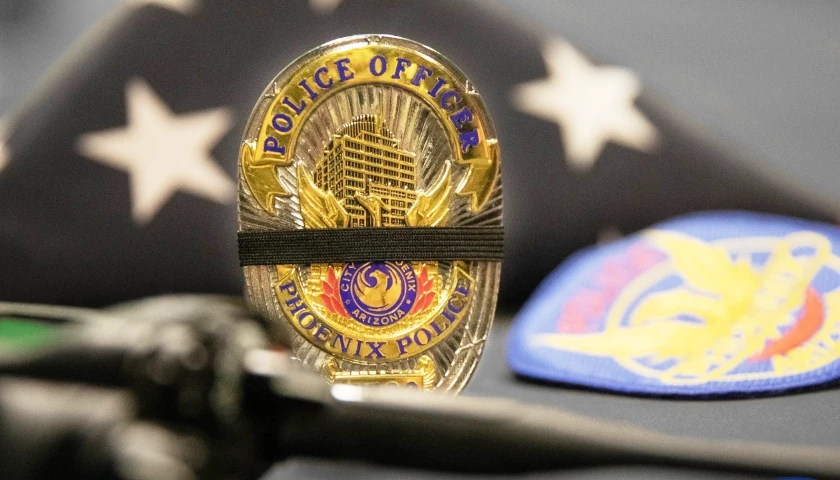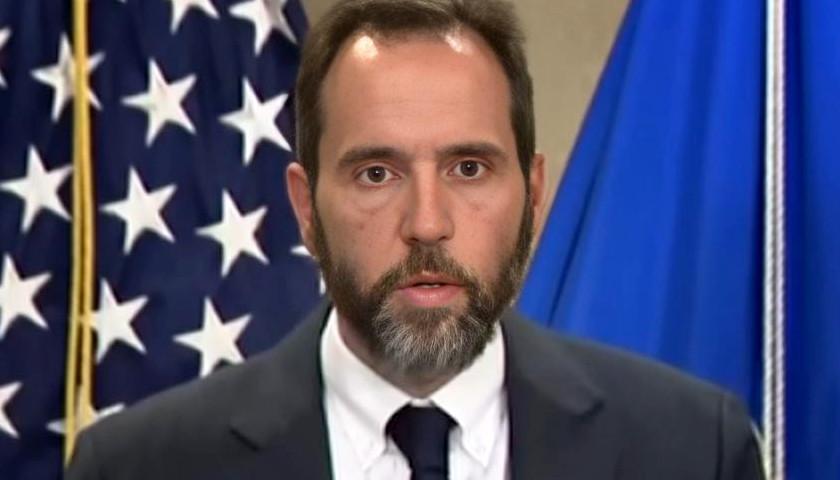An attorney for the Arizona Conference of Police and Sheriffs (AZCOPS) is releasing videos refuting the Department of Justice’s June report, which claimed that the Phoenix Police Department violated the rights of suspects during various incidents. Steve Serbalik has issued five videos so far, revealing key details about the incidents that the DOJ selectively left out of its report.
One of the incidents involved an arrest for domestic violence, labeled U10. Serbalik explained in the video how the DOJ left out facts that exonerated the police officers. They were addressed in police reports, videos, and other data released by PPD to refute the report.
Serbalik said the DOJ report only discussed how officers responded to a report that a man was suicidal, omitting the events leading up to his arrest. The report claimed that the man “lost consciousness” due to how the officers handled him, and that “PhxPD officers use these dangerous compression restraints against people experiencing a behavioral health crisis who do not present a risk to officers or others.”
Serbalik said the report failed to mention that prior to the confrontation, four different people had called 911 to report a man assaulting a woman at a gas station who was crying for help. The incident was caught on surveillance video. The report also left out the fact that the woman had called the police earlier that day to report an incident with him and a neighbor, stating that she was afraid he was going to hurt her minor children and was known to carry knives. When they spoke with her, she had a bloody lip.
Serbalik said when the officers confronted the man at the gas station, he had a small edge weapon. Since the officers said they believed he had committed multiple domestic violence offenses, they attempted to arrest him. He resisted arrest, which is a class 6 felony, so they tased him. Serbalik said the man stood up immediately afterward and walked to the patrol vehicle. He did not complain about losing consciousness, contrary to the DOJ’s report, and the fire department looked him over and determined he did not need further medical care.
A second incident, U34, involved an officer using a PepperBall launcher near a violent man in a mental health facility who was damaging a table or chair. The officer shot the PepperBall launcher at a wall to warn the man after he refused to comply, and he calmed down. However, the DOJ report stated that the officer shot the PepperBalls directly at the man and failed to mention his violent behavior. “PhxPD officers fired Pepperballs at a man in a behavioral health crisis less than two minutes after arriving on scene,” it said.
The report emphasized that the officers were advised in advance that the man had “started to calm down,” but the officers’ bodycam footage shows him refusing to sit down and instead turning to walk toward a door going to the lobby.
Serbalik said in his video that the officers successfully took him to a facility with a higher level of psychiatric care. DOJ faulted PPD for not dispatching a mental health crisis team instead.
Serpalik observed, “It’s unclear what additional mental health expertise, additional mental health practitioners would have brought to the situation, especially given if mental health practitioners at the behavioral health clinic were explicitly requesting police officers to assist in getting the situation under control.”
A third incident, U01, involved the fatal shooting of a man with behavioral health problems that was extensively covered in the media. Serbalik quoted the DOJ report in his video, which claimed that “Phoenix police officers shot a man” who “presents no immediate threat,” who was “not physically aggressive,” and “never threatened the officers.”
Serbalik said the report left out details. Police were contacted after Matthew Begay threatened to jump out the second-story window of a group home. The caller requested the mobile crisis team, but the team was 20 minutes away, so officers arrived first. They asked Begay to come downstairs.
He refused, Serbalike said, and stated that he wanted to die, holding a knife out with the blade down. He then began moving down the stairs towards the officers with the knife held out. The officers attempted to taser him, Serbalik said but failed to stop him. Finally, one officer shot him three times when he got within 6 feet of them, killing him. An autopsy found he had methamphetamine, marijuana, and alcohol in his system.
A fourth incident involving a fatal shooting, U04, was also heavily covered in the media. The DOJ report described the incident involving James Garcia, “In one case, officers shot and killed a man sitting in a parked car after they exposed themselves to an avoidable and dangerous situation.”
The report only said there was a call about a “man with a knife,” leaving out that the caller said he had previously been stabbed by Garcia, who had returned and was threatening him again. The report did not mention that Garcia lied to officers about his identity, which Serpalik said was likely due to there being a warrant out for his arrest. Garcia was confused to comply with their commands.
The officers raised their handguns after Garcia raised his handgun — but the DOJ report merely said he had a gun, it did not state that he raised it. An autopsy report found fentanyl in his body, which the report also failed to mention.
Serpalik said in his video that some people created a false narrative that Garcia was sleeping and unarmed, but the bodycam footage refuted it. After protests occurred, PPD asked the DOJ to investigate the incident. The DOJ issued a statement clearing them initially, so Serpalik said it was strange it would be brought up again now.
A fifth incident addressed by Serpalik, U08, discussed the shooting of armed robber Jacob Harris. Serpalik said it all started after police tied together 30 robberies in eight jurisdictions, which the report neglected to mention. After identifying the getaway vehicle, police began surveilling it. They caught Harris and his accomplices robbing a Whataburger. The suspects held the employees hostage while robbing it, he said, which caused the officers to refrain from intervening during the robbery.
When the suspects left, officers used a grappler to disable the vehicle and flashbangs to disorient them. Harris ran from the car with a gun. Serpalik said he was seen in surveillance footage holding the gun, yet his father later claimed the police planted it on his body.
The report omitted all of that information, beginning instead with, “In one incident, after shooting a man…” The DOJ accused the police of not rendering aid fast enough to Harris after shooting him, taking nine minutes after he was down and using a police dog to drag him back. Serpalik said this was unrealistic since three getaway suspects were still in the car. They were arrested, and more firearms were found in the vehicle. The report did not mention the accomplices.
Serpalik said the incident was already litigated in court, with a federal district court judge finding in favor of PPD, and the Ninth Circuit Court of Appeals upholding the decision.
The Arizona Sun Times previously covered PPD’s release of documents and videos refuting the DOJ’s report. Insiders told The Sun Times that the DOJ is attempting to force a consent decree on PPD like it has done in other big cities, in order to gain control over the agency.
– – –
Rachel Alexander is a reporter at The Arizona Sun Times and The Star News Network. Follow Rachel on Twitter / X. Email tips to [email protected].
Photo “Phoenix Police Department Badge” by Phoenix Police Department.





